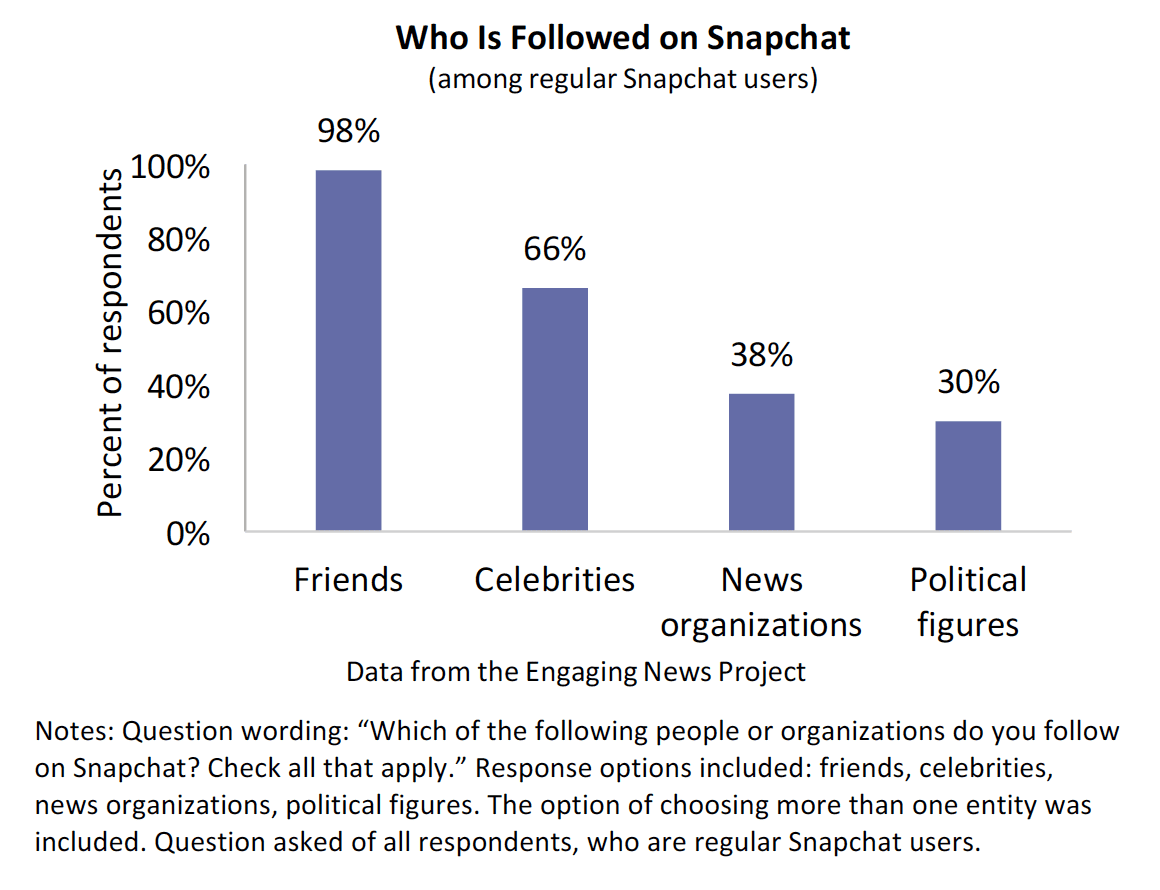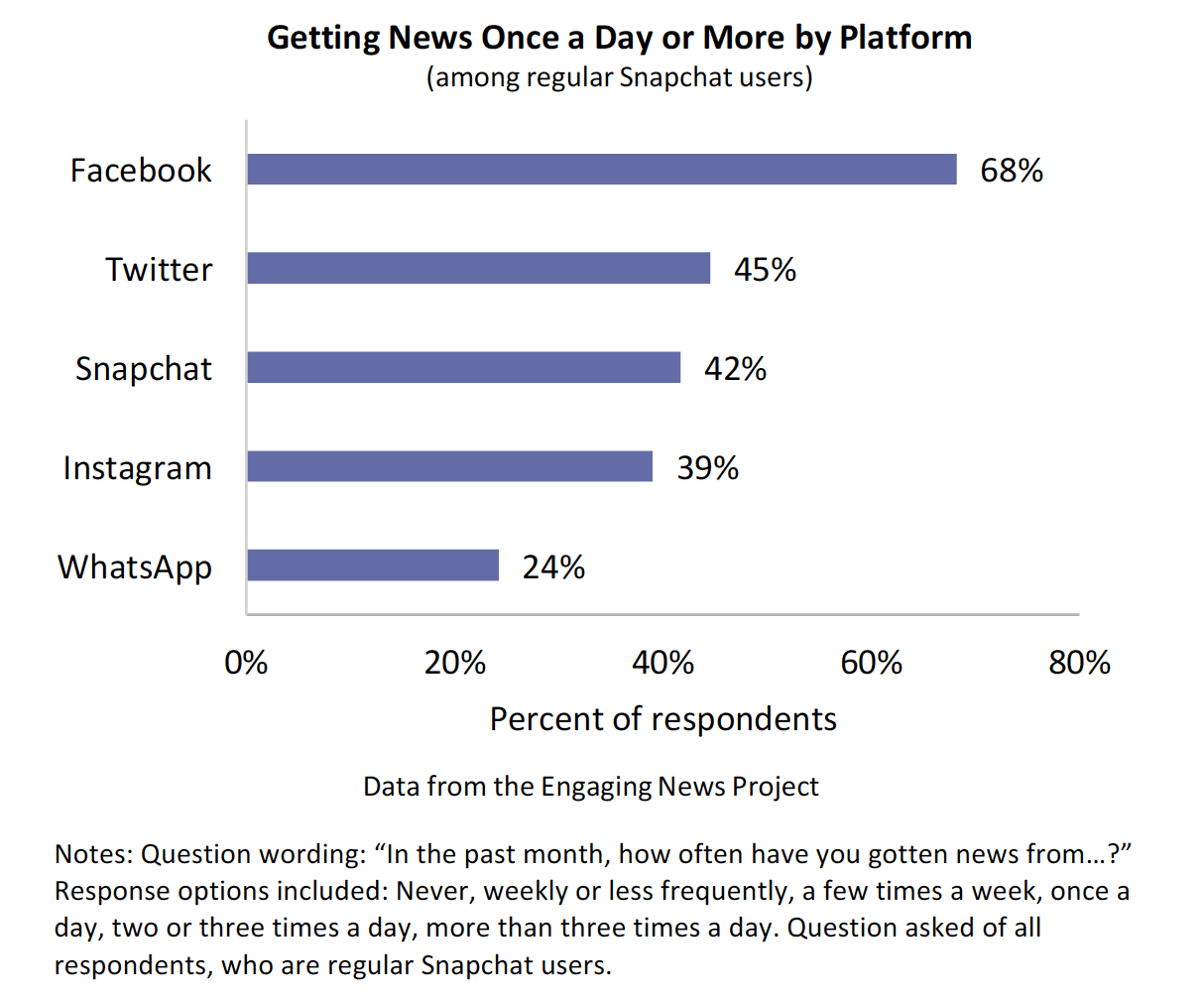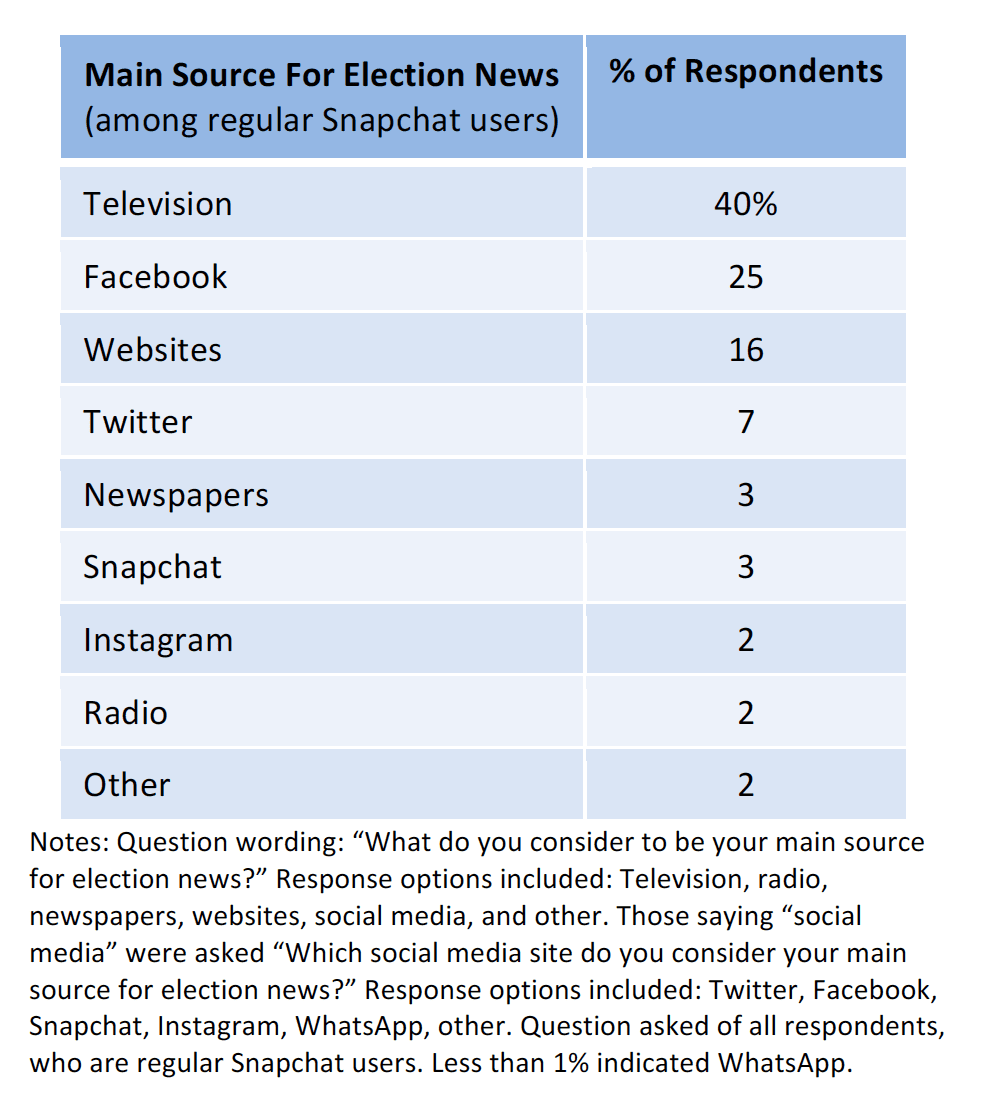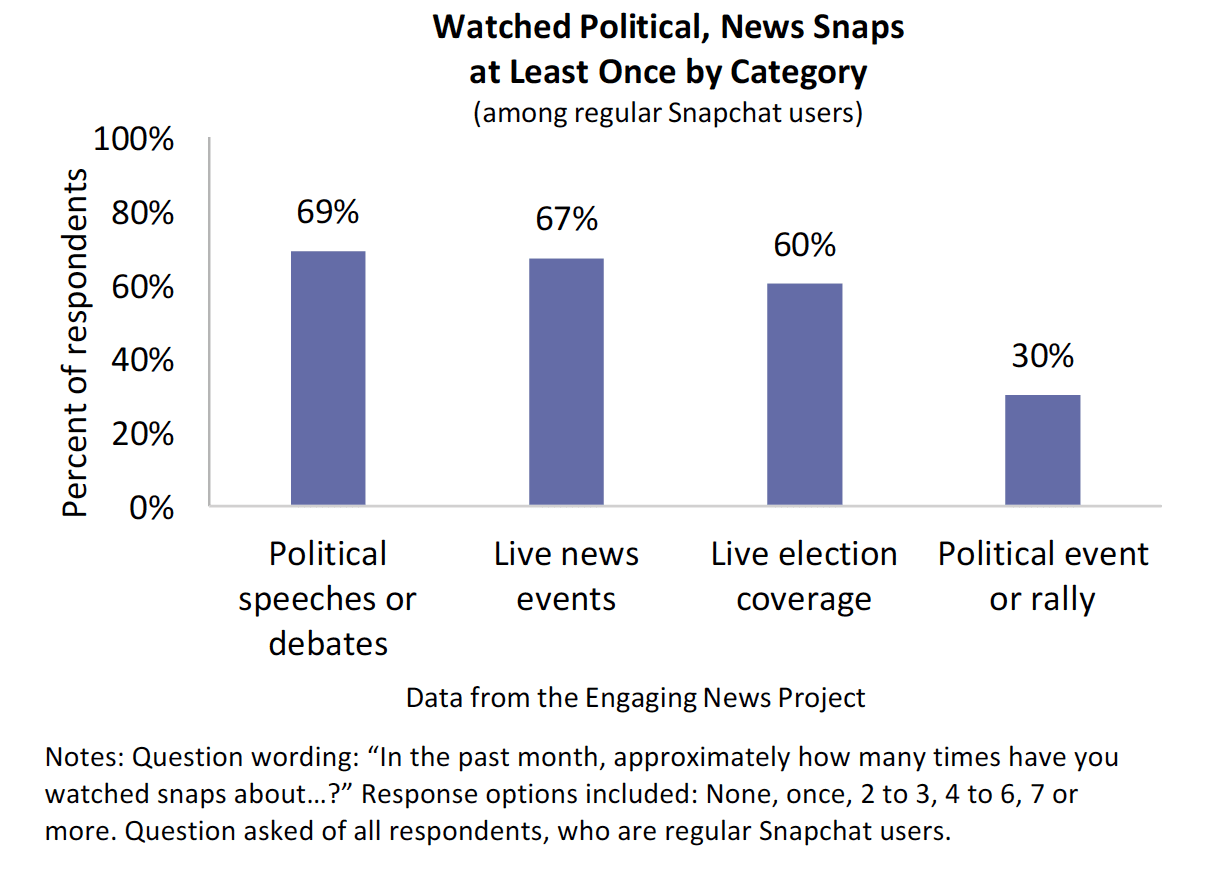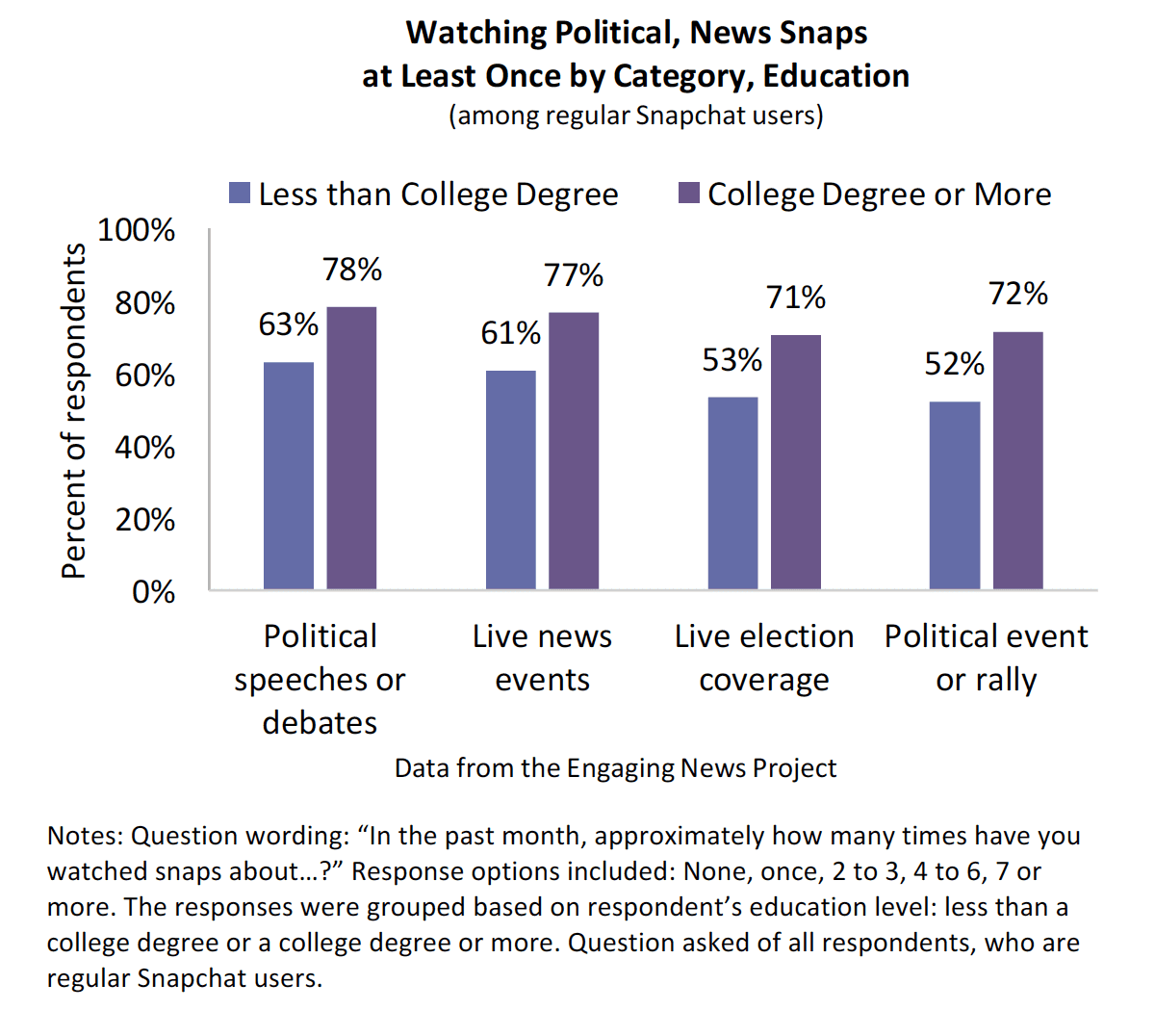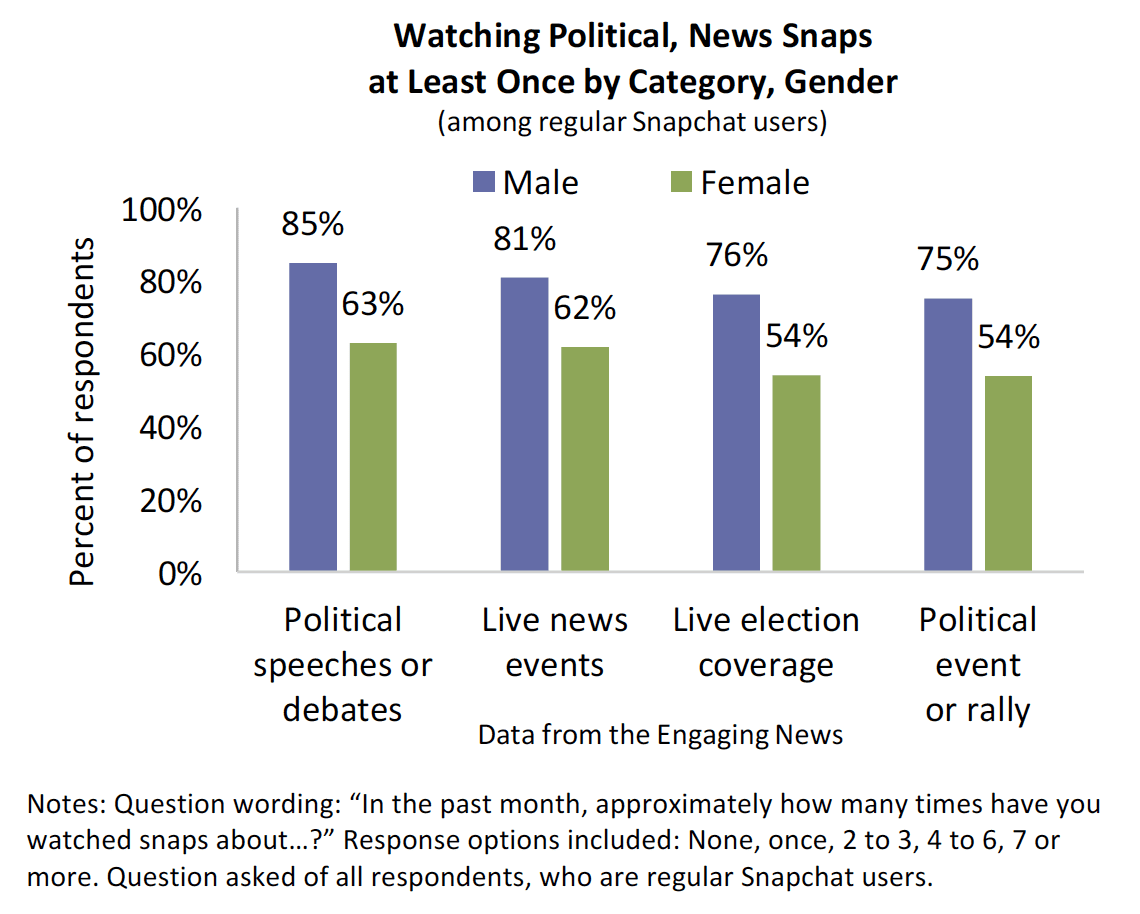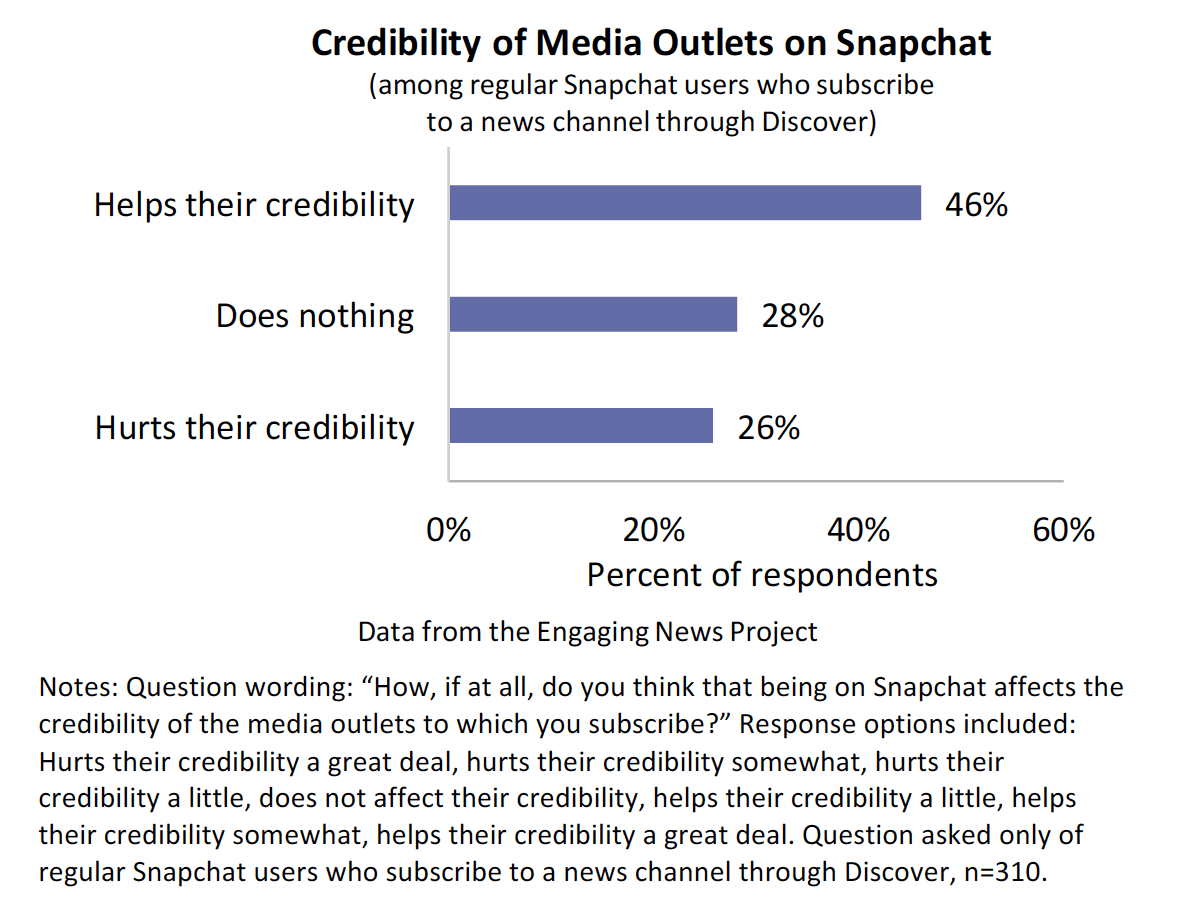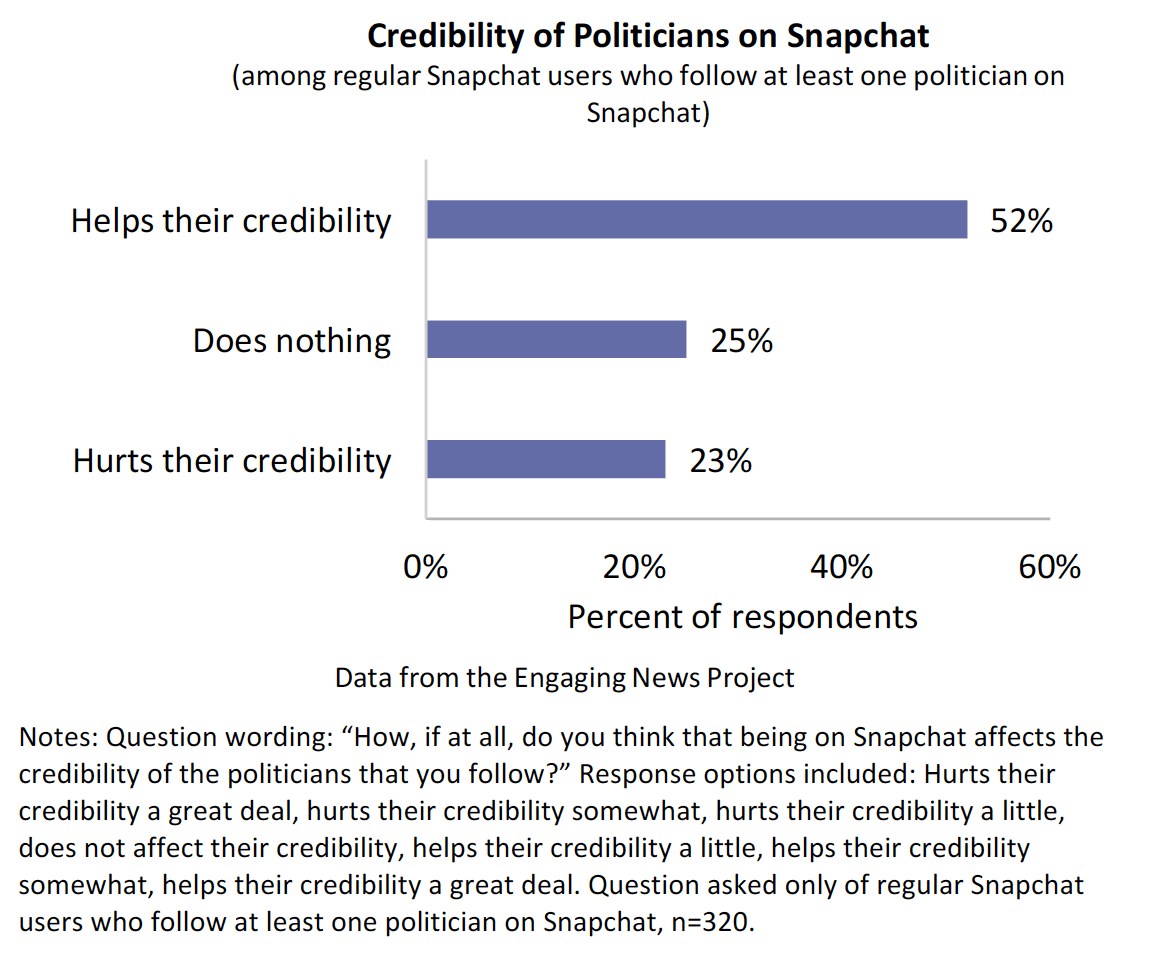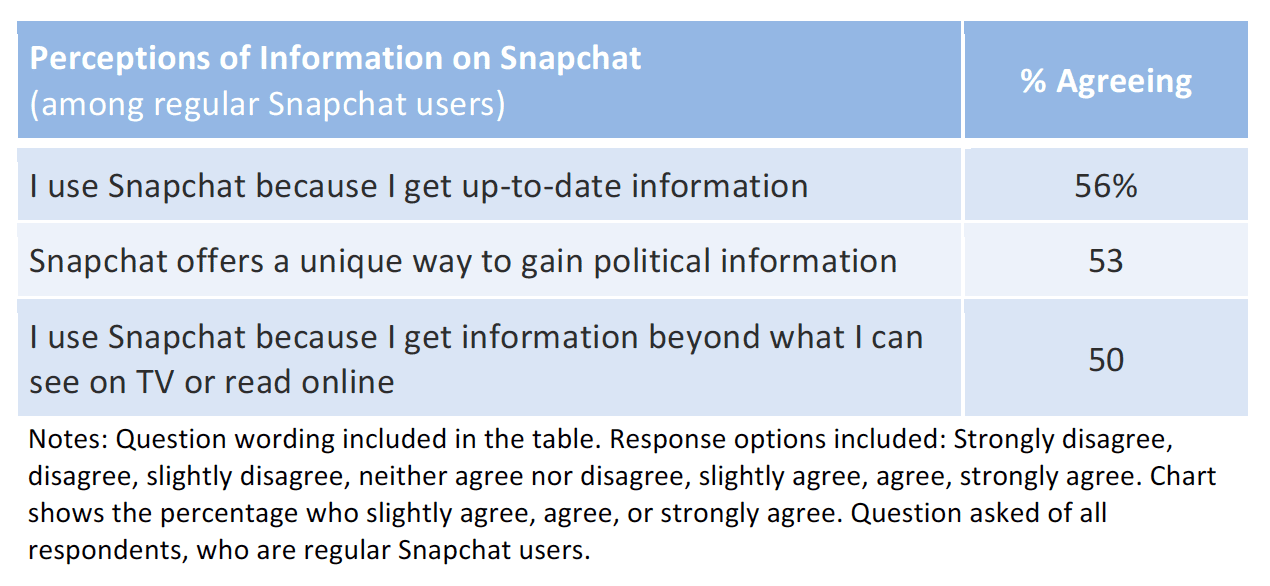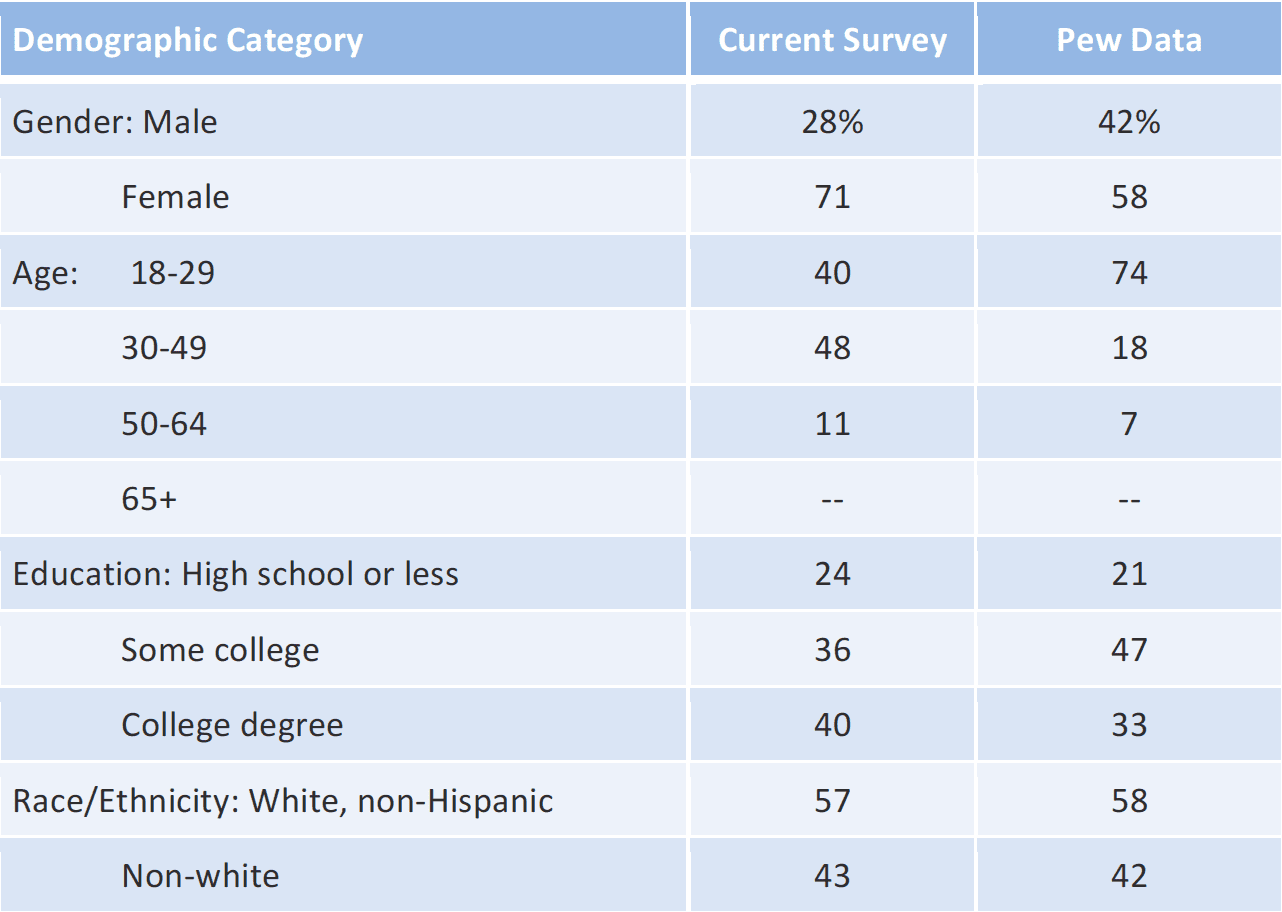
Apps like Snapchat are increasingly popular, yet little is known about how people use these apps for news and politics. Political candidates and news organizations alike are experimenting with the popular platform, and there is much to be learned about how Snapchat users engage with news and politics on the app. In this study, we examine what regular Snapchat users reported about their interactions with political candidates, news organizations, and journalists. Survey respondents told us how these interactions shaped their attitudes and knowledge about politics. This report was funded by the John S. and James L. Knight Foundation.
In the weeks leading up to the 2016 election, we surveyed Snapchat users about their use of the app, specifically for news and politics. Results are based on a survey of 977 regular Snapchat users fielded the week before Election Day. These findings are not representative of all Snapchat users; the data are from an opt-in online panel.
Key Findings
Findings suggest that:
- Although nearly all regular Snapchat users follow friends on the app, 38% follow a news organization and 30% follow a politician.
- Respondents following news organizations and political figures on Snapchat are more likely to be educated and male.
- Ahead of the 2016 election, more than two-thirds of regular users reported watching snaps about political speeches or debates and live news.
- Of those who followed journalists on Snapchat, half believed that being on Snapchat helps journalists’ credibility and 24% believed that it does nothing. Those following politicians reported similar percentages in assessing how Snapchat affects politicians’ credibility.
- Those seeing political content on Snapchat like that it is easy to consume and informative, but dislike that the information is so brief, worry about its political bias, and wish for less negativity.
Implications for Newsrooms
This study paints a picture of limited political engagement on Snapchat. The app is, mostly, seen as a social space for keeping in touch with friends and keeping tabs on celebrities. Many do not feel it is a space for politics, though around a third of regular users follow news organizations or politicians. Less than half of regular users say they get daily news from Snapchat.
That being said, many regular users engaged with politics on Snapchat during the 2016 campaign, and most of this engagement centered on prominent events. For example, more than two-thirds of users watched snaps related to political speeches or debates, and six in ten had friends who used political geofilters. Around a third of users said that they learned political or election information from Snapchat.
Political use of Snapchat is not for everyone: Those who do engage with politics on Snapchat were more likely to be male, younger, and more educated. This is true for nearly all measures relating to using Snapchat for news or politics.
Our findings also suggest that engaging on Snapchat may prove beneficial for the credibility of news makers and providers. Around half of respondents following at least one journalist said that being on Snapchat enhanced journalists’ credibility, while a quarter thought it had no effect. Similar results appear regarding politicians’ credibility among those following at least one politician.
The Study
Higher Education Drives Snapchat Use, Especially for News & Politics
Our analysis shows that education – particularly having at least a four-year college degree – drives general Snapchat use as well as its use for news and politics. Overall, more than one-third of regular users report posting daily or more frequently, as shown in the following chart. These frequent snappers vary significantly by education – 43% of those with at least a four-year college education post once a day or more while only 31% of those with less education said they post frequently. Of regular users who report never posting, 73% had less than a four-year college degree. Men were more likely than women to post daily or more frequently (49% vs. 30%), as were those under 45 years old (40%) compared to those 45 and older (14%).
A vast majority of regular Snapchat users, 98%, follow their friends on Snapchat. As seen in the chart below, 38% of regular users follow news organizations and 30% follow political figures on Snapchat.
However, users who are more educated are more likely to follow news organizations and political figures. Regular Snapchat users with a four-year college degree or higher follow news organizations (46%) and political figures (40%) more than less educated users (32% news; 24% political figures).
Although Snapchat may not be many people’s main news source, it is a source for news. Forty-two percent of regular users reported getting news at least once a day on Snapchat.
Those with a higher education and the young were more likely to get news from the app. Users with at least a four-year college degree reported getting news from Snapchat more often (53% get news once a day or more) than those with less education (35% get news once a day or more). Nearly half of users under 45 reported getting news from Snapchat at least once a day (46%), significantly more than users 45 years old and older (27%).
Election Drove Political Uses of Snapchat
Snapchat, though widely used, is a limited source for election news when considered among other platforms and sources. As seen in the following chart, regular users of Snapchat indicated that television and Facebook were their main sources for election news, mirroring a survey conducted by the Pew Research Center.
Even though only three percent of users cited Snapchat as their main source for election news, more than half reported watching political or news snaps about media events. As shown in the next chart, we asked regular Snapchat users how often they watched snaps about debates/speeches, live news events, live election coverage, and political rallies.
Parsing the responses further, we found that several groups were more likely to watch snaps related to news and politics. As the following charts show, younger, more educated, and male regular Snapchat users were more likely to watch political and news snaps in the run-up to the 2016 election.
Geofilters – location-based overlays on snaps – were used by a majority of respondents (70%).1 Election news and events were featured via geofilters. In the month preceding the election, 63% of our respondents saw friends using political geofilters and 40% used political geofilters themselves.2
Snapchat Presence Boosts Credibility of News Media, Journalists, & Politicians
Of the Snapchat users who follow news organizations, journalists, or political figures, nearly half reported that being on Snapchat positively affected those entities’ credibility.
For the 31% of regular users who subscribe to a news channel through Snapchat’s Discover feature, 46% said that being on Snapchat helps that media outlet’s credibility. Just over one quarter of users (26%) said being on Snapchat hurts the news media’s credibility, and 28% said it makes no difference.
Snapchat users who follow individual journalists (29%) responded in similar ways in regards to the journalist’s credibility. Half of those users reported that journalists’ presence on Snapchat helps their credibility, while about one quarter (26%) said that it negatively affects journalists’ credibility.
Of the regular users polled, 33% followed politicians on Snapchat; those who did were more likely to have at least a four-year degree and be younger than 45. More than half of these users said that being on Snapchat helps a politician’s credibility, while 23% said it negatively impacts a politician’s credibility.
A majority of those users who followed politicians on Snapchat felt that politicians’ presence on the app made them more personable (73%).3
Politics on Snapchat: Not for Everyone
Our findings suggest that the majority of regular users do not view Snapchat as an inherently political space. Less than half (41%) felt that Snapchat is “an appropriate place to talk about politics” and only 36% agreed with the statement “I like it when accounts I follow post political snaps.”4
When asked what they did like about politics on Snapchat, those encountering it (75% of the sample) liked that the app made political information readily available. In their open-ended responses, 30% mentioned Snapchat as being informative and 19% cited that the information was easy to consume.5 Examples of what people wrote are included below:
- “I like political content on Snapchat because it gives me information when I cannot see it on TV.”
- “It’s a short burst of info that is not overwhelming, gets straight to the point.”
When asked what they did not like about political content on Snapchat, many regular users didn’t list specific dislikes, but those who did mentioned that it was not informative or contained biased information (17%) or that politics seemed negative and not fun (7%).6 Examples of what people wrote are included below:
- “It seems like a limited space to give a great deal of information.”
- “I want Snap to be a fun, silly place, not serious. Politics doesn’t belong here.”
Learning About Politics on Snapchat
A majority of users found Snapchat good for political information that is timely and unique.
A sizable minority of regular users said that they learned about political information from Snapchat (44%).7 Others reported learning “something new about the 2016 presidential campaign” from Snapchat (38%), while 36% used Snapchat to get information about specific political candidates.8
Those who reported learning political information via Snapchat were significantly more likely to be younger (under 45) and have at least a four-year degree.
Methodology
Data for this survey were gathered between November 1 and 7, 2016, by Survey Sampling International (SSI). For this survey, all respondents had to be 18 years of age or older and be U.S. residents. Most importantly, they had to report being regular Snapchat users. SSI asked panelists “Which of the following mobile apps do you use on a regular basis?” Only those who responded “Snapchat” qualified for the survey. As such, our respondents do not match basic demographics of the U.S. We note that these results are not representative of regular Snapchat users because the data were not collected using probability sampling. This method does, however, give insight into how this subset of regular Snapchat users think about the app. Below, see a comparison between our respondents and a sample from Pew who use Snapchat. Note that the Pew data are for those who use Snapchat, as opposed to regular Snapchat users. Thus, it is not possible to know whether the demographic differences are due to the question wording or the different samples. In total, we analyze data from 977 respondents.9
SUGGESTED CITATION:
McGregor, Shannon and Stroud, Natalie Jomini. (2017, June). A survey of Snapchat users: media, politics, and the 2016 election. Center for Media Engagement. https://mediaengagement.org/research/snapchat
- Question wording: “In the past month, how often have you used geofilters on Snapchat?” Response options included: Never, weekly or less frequently, a few times a week, once a day, two or three times a day, more than three times a day. Question asked of all respondents, who are regular Snapchat users. Text is for those who checked a response option other than Never. [↩]
- Question wordings: “In the past month, how often have you seen friends use political geofilters in their snaps?” Response options included: Never, weekly or less frequently, a few times a week, once a day, two or three times a day, more than three times a day. Question asked of all respondents, who are regular Snapchat users. “In the past month, how often have you used political geofilters in your snaps (like a filter for a specific debate or campaign rally)? Response options included: Never, weekly or less frequently, a few times a week, once a day, two or three times a day, more than three times a day. Question asked of respondents who indicated that they had used geofilters in the past month, n= 684. Text is for those who checked a response option other than Never. [↩]
- Question wording: “How, if at all, do you think that being on Snapchat affects how personable you view the politicians that you follow? Response options included: Makes them a great deal more personable, makes them somewhat more personable, makes them a little more personable, does not affect how personable they are, makes them a little less personable, makes them somewhat less personable, makes them a great deal less personable. Text is for those indicating that Snapchat makes the politicians they follow a little more personable through a great deal more personable. Question asked only of regular Snapchat users who follow at least one politician on Snapchat, n=316. [↩]
- Question wording: “Snapchat is an appropriate place to talk about politics.” Response options include: Strongly disagree, disagree, slightly disagree, neither agree nor disagree, slightly agree, agree, strongly agree. Question asked of all respondents, who are regular Snapchat users. “I like it when the accounts I follow post political Snaps.” Response options include: strongly disagree, disagree, slightly disagree, neither agree nor disagree, slightly agree, agree, strongly agree. Question asked of all respondents, who are regular Snapchat users. Text is the percentage who slightly agree, agree, or strongly agree. [↩]
- Question wording: “What do you like about political content on Snapchat? Please give as much detail as possible.” Multiple responses were permitted; the most common categories are reported above. Two coders evaluated 151 of the open-ended responses for reliability purposes. Krippendorff’s alpha was 0.81 for informative, 0.79 for easy to consume and 0.79 for entertaining. Asked only of regular Snapchat users who come across political content on Snapchat (n=728 who responded to the question). [↩]
- Question wording: “What do you dislike about political content on Snapchat? Please give as much detail as possible.” Multiple responses were permitted; the most common categories are reported above. Two coders evaluated 149 of the open-ended responses for reliability purposes. Krippendorff’s alpha was 0.76 for not informative, 0.88 for negative content, and 0.78 for excessive political content. Asked only of regular users who came across political content on Snapchat (n=726 who responded to the question). [↩]
- Question wording: “I have learned political information from Snapchat.” Response options include: Strongly disagree, disagree, slightly disagree, neither agree or disagree, slightly agree, agree, strongly agree. Question asked of all respondents, who are regular Snapchat users. Text is the percentage who slightly agree, agree, or strongly agree. [↩]
- Question wordings: “I learned something new about the 2016 presidential campaign from Snapchat.” Response options include: Strongly disagree, disagree, slightly disagree, neither agree or disagree, slightly agree, agree, strongly agree. Question asked of all respondents, who are regular Snapchat users. “I use Snapchat because I get information about political candidates.” Response options include: Strongly disagree, disagree, slightly disagree, neither agree or disagree, slightly agree, agree, strongly agree. Question asked of all respondents, who are regular Snapchat users. Text is the percentage who slightly agree, agree, or strongly agree. [↩]
- We eliminated data for those who were less than 18 years of age, were not U.S. residents, or did not indicate that they were regular Snapchat users (n=344). We also eliminated data from 35 respondents who left junk data (e.g. random strings of letters in the open-ended fields.) [↩]




